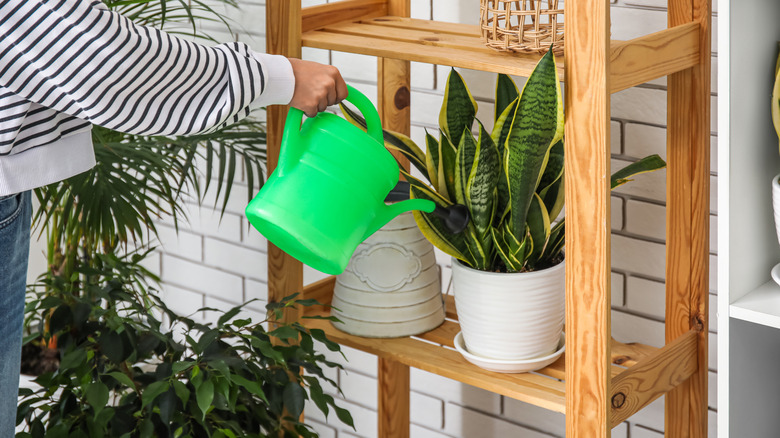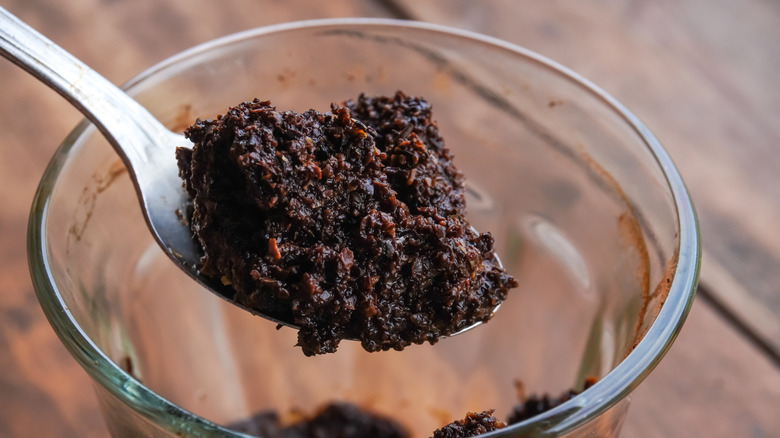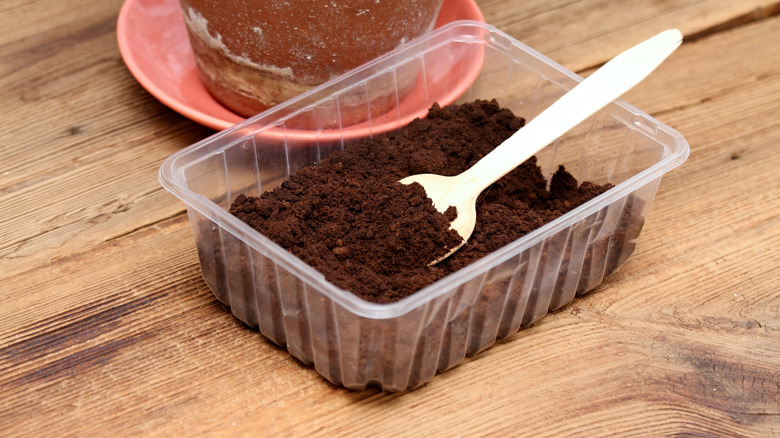The Natural Fertilizer Your Snake Plant Needs Is Already Sitting In Your Kitchen
Snake plants (Dracaena trifasciata) are one of the most common houseplants for a reason: No matter how "green" your thumb is, you can likely keep a snake plant alive. Unlike some plants, they don't require fussy upkeep. They're identifiable by their upright, pointy leaves, which are thick and succulent-like. These leaves hold on to water, allowing the plant to withstand long periods of drought. In other words, even if you forget to water it for some time, the plant will manage just fine. Caring for your snake plant is easy in pretty much every other way as well, making them highly satisfying to grow. They live a long time, grow quickly, are pest-resistant, aren't too picky about light or soil, and aren't fussy about fertilization. In fact, one common household item you can fertilize your snake plant with is used coffee grounds.
Snake plants don't need any extra plant food in the first year after potting, since they get all the nutrients they need from the potting mix. After that, it's enough to fertilize once a month or so during the growing season, which is in the spring and summer. Plants in low-light conditions should receive less fertilizer, while those in bright conditions can get more. Regular houseplant fertilizers should be diluted at half strength for snake plants, since over-fertilizing can damage the roots. But leftover coffee grounds are a helpful supplement that's unlikely to overload the plant — and one that may be sitting in your kitchen already.
Why coffee grounds work as snake plant fertilizer
Coffee grounds supply each of the three main nutrients that plants need — nitrogen, phosphorus, and potassium — in a ratio of 2.28-0.06-0.6. They also provide other important nutrients, including potassium, magnesium, and chloride. While coffee grounds are higher in nitrogen than is typically necessary for snake plants, that nitrogen is released gradually as the microorganisms in the soil break down the grounds, much like with slow-release fertilizer. This slower method of releasing nutrients tends to work well for snake plants. Coffee grounds also improve soil structure and drainage, as microorganisms use the nutrients in them to grow.
One caveat is that coffee grounds can't provide all the nutrition your snake plant needs. The quantities of useful nutrients in used coffee grounds are simply not sufficient. So, it's important to use coffee grounds as a supplement rather than your sole fertilizer.
How to fertilize a snake plant with coffee grounds
Only used coffee grounds help indoor houseplants thrive — fresh grounds are too acidic. The coffee grounds should also be completely dry before you add them to the soil. For snake plants, it's enough to sprinkle a layer sparingly over the potting medium. A thicker layer can be detrimental, blocking airflow and water absorption and potentially leaving too much caffeine residue in the soil.
Alternatively, you can make a liquid fertilizer by steeping the coffee grounds in liquid for a few nights; only about a teaspoon of coffee grounds should be used for every gallon of water. Another foolproof way to make use of old coffee grounds is to add them to your compost bins, allowing them to decompose before using the compost for your snake plants. This process makes more nutrients available to the plant and also results in a more balanced fertilizer thanks to the other ingredients in the mix.
Regardless of the method, use a light hand when fertilizing with coffee grounds or compost. You can apply this natural plant food to your snake plants one or two times during the growing season, supplementing with a balanced and diluted fertilizer during the other months. Avoid fertilizing snake plants in the fall and winter, when they grow slowly.


